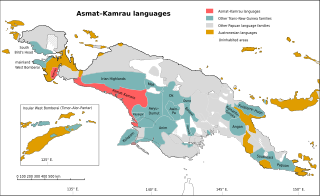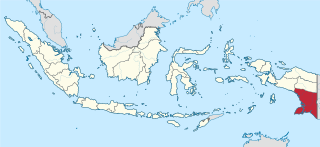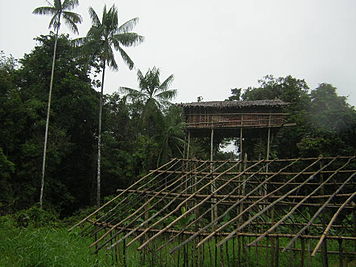
Papua is a province of Indonesia, comprising the northern coast of Western New Guinea together with island groups in Cenderawasih Bay to the west. It roughly follows the borders of Papuan customary region of Tabi Saireri. It is bordered by the sovereign state of Papua New Guinea to the east, the Pacific Ocean to the north, Cenderawasih Bay to the west, and the provinces of Central Papua and Highland Papua to the south. The province also shares maritime boundaries with Palau in the Pacific. Following the splitting off of twenty regencies to create the three new provinces of Central Papua, Highland Papua, and South Papua on 30 June 2022, the residual province is divided into eight regencies and one city (kota), the latter being the provincial capital of Jayapura. The province has a large potential in natural resources, such as gold, nickel, petroleum, etc. Papua, along with five other Papuan provinces, has a higher degree of autonomy level compared to other Indonesian provinces.
Michael Clark Rockefeller was a member of the Rockefeller family. He was the son of New York Governor and later U.S. Vice President Nelson Rockefeller, a grandson of American financier John D. Rockefeller Jr. and a great-grandson of Standard Oil co-founder John D. Rockefeller Sr.

The Dani are an ethnic group from the Central Highlands of Western New Guinea in Baliem Valley, Highland Papua, Indonesia. Around 100,000 people live in the Baliem Valley, consisting of representatives of the Dani tribes in the lower and upper parts of the valley each 20,000 and 50,000 in the middle part. The areas west of the Baliem Valley are inhabited by approx 180,000, representatives of the Lani people, incorrectly called "Western Dani". All inhabitants of Baliem Valley and the surrounding areas are often called Dani hence they are also sometimes conflated with other highland tribes such as Lani in the west; Walak in the north; Nduga, Mek, and Yali in the south and east.
The Bauzi or Baudi tribe consists of a group of 2,000 people living in the north-central part of the Indonesian province of Papua. The Bauzi area consists of much of the west side of lower Mamberamo River area in northern Papua. The Bauzi people lived on hunting and gathering in the jungle. While the Bauzi people were historically an animistic people group, they are now 65% Christian. For the most part, tribal warfare is no longer a large part of Bauzi culture and all Bauzi people speak the same language. In recent years, linguists have been studying the language and translating various literature, including the Bible, into the Bauzi language.

Western New Guinea, also known as Papua, Indonesian New Guinea, and Indonesian Papua, is the western, Indonesian half of the island of New Guinea. Since the island is alternatively named Papua, the region is also called West Papua.

Tobias Schneebaum was an American artist, anthropologist, and AIDS activist. He is best known for his experiences living and traveling among the Harakmbut people of Peru, and the Asmat people of Papua, Indonesia.

The Asmat are an ethnic group of New Guinea, residing in the province of South Papua, Indonesia. The Asmat inhabit a region on the island's southwestern coast bordering the Arafura Sea, with lands totaling approximately 18,000 km2 (7,336 mi2) and consisting of mangrove, tidal swamp, freshwater swamp, and lowland rainforest.
The Kombai are a Papuan people living in the Indonesian province of South Papua, more specifically in Mappi Regency. Their total population is about 5,650.

The Asmat – Kamrau Bay languages are a family of a dozen Trans–New Guinea languages spoken by the Asmat and related peoples in southern Western New Guinea. They are believed to be a recent expansion along the south coast, as they are all closely related, and there is little differentiation in their pronouns.
Momuna (Momina), also known as Somahai, is a Papuan language spoken in Yahukimo Regency, Highland Papua and Asmat Regency, South Papua, Indonesia.

The Marind or Marind-Anim are an ethnic group of New Guinea, residing in the province of South Papua, Indonesia.

Kaure is a Papuan language of West Papua. It is spoken in the villages of Lereh, Harna, Wes, Masta, and Aurina.
Korowai (Kolufaup) is a Trans-New-Guinean language spoken in South Papua, Indonesia. It is spoken by the Korowai people who live along the Becking River.

Peter W. Van Arsdale is an American academic who retired as director of African Initiatives at the University of Denver, Josef Korbel School of International Studies, where he also served as Senior Lecturer. He previously served as a senior researcher for eCrossCulture Corporation, based in Colorado. An applied cultural anthropologist, he has worked in E. Africa, S.E. Asia, the Balkans, Latin America, the Caribbean, and North America, emphasizing community water resources, human rights, refugee resettlement, and humanitarian intervention. He is a noted author, journal editor, and former president of the National Association for the Practice of Anthropology and known analytically for his “tree of rights” and his “theory of obligation.” He is co-founder of The Denver Hospice, and co-discoverer in 1974 of a band of previously uncontacted Citak people in Indonesian New Guinea. Since 1979, he has been a fellow of The Explorers Club. He currently serves as Affiliate Faculty Member at Regis University.
The Brazza River is a river in Papua province, Indonesia. The Brazza River has its source at over 3000 meters of elevation in the Jayawijaya or Maoke Mountains of central Papua in Yahukimo Regency and flows south to the lowland rainforests of Asmat Regency before meeting the Pulau River, which flows southeast to the Arafura Sea.

South Papua, officially the South Papua Province, is an Indonesian province located in the southern portion of Papua, following the borders of the Papuan customary region of Anim Ha. Formally established on 11 November 2022 and including the four most southern regencies that were previously part of the province of Papua and before 11 December 2002 comprised a larger Merauke Regency, it covers an area of 117,849.16 km2, and it had a population of 522,215 according to the official estimates for mid-2022, making it the least populous province in Indonesia.
Kepi is a town in Mappi Regency, South Papua, Indonesia. Following the formation of Mappi Regency in 2002, the town became its administrative seat.
Isyaman is an inland village in Mappi Regency, South Papua, Indonesia.

The Mamberamo Lakes Plains are a large, flat low-lying area of the Mamberamo River basin in the Indonesian province Papua on the island of New Guinea. The plain is defined by the meandering tributaries of the Mamberamo, and includes hundreds of oxbow lakes. It is 300 kilometers long and about 50 kilometers wide, and is entirely enclosed by mountains apart from the outlet of the Mameramo. It is inhabited in the west, but the eastern lobe is largely uninhabited.

Central Papua, officially the Central Papua Province is an Indonesian province located in the central region of Western New Guinea. It was formally established on 11 November 2022 from the former eight western regencies of the province of Papua. It covers an area of 61,072.92 km2 and had an officially estimated population of 1,430,951 in mid 2022. It is bordered by the Indonesian provinces of West Papua to the west, the residual province of Papua to the north and northeast, by Highland Papua to the east. and by South Papua to the southeast. The administrative capital is located in Wanggar District in Nabire Regency, although Timika is a larger town.














